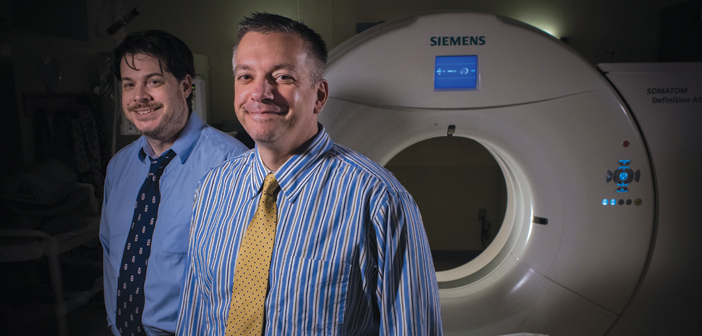For now the lab’s more novel services are being used in the educational and research spheres, which Merck says is the case at most institutions. “They’re not using it in billable ways but for patient satisfaction and research,” he says. For example, a 3-D print may help a surgeon visualize a procedure, but she’ll likely find it more helpful when explaining her plan to her patient—who after the surgery can take the model home as a souvenir.
Merck and Collins want to get beyond that cool factor. After “walking” through a brain or a heart or a spine in the Yurt virtual reality theater, “clinicians inevitably say, ‘This is awesome! What do you do with it?’” Merck says.
“The stage it’s at now, it’s a lot of hardware that goes into making it happen. It’s analogous to back when computers filled an entire room,” Oyelese says. If the images were projected in a VR headset like the Oculus Rift, it could change the game. “We’ve always tried to push the limit and see what we could come up with,” he says of Collins, with whom he’s worked in the operating room for many years.
Collins is also a longtime colleague of Damian Dupuy, MD, professor of diagnostic imaging and a pioneer in image-guided tumor ablation. Dupuy recently tapped Collins and Merck to work with him on a study of lung tumor recurrence in ablation patients. The procedure involves skewering the tumor with a small antenna to destroy the cancer cells with microwave energy. Follow-up CT scans, immediately after the procedure and then a month later and every three months after that, are performed to make sure all of the cancer cells are gone. The changes can be so subtle it can take a year or more before a radiologist can confidently say the tumor is back.
Dupuy wants to cut the wait time. Armed with longitudinal data from a couple dozen patients, Collins is creating 3-D models of their tumors and thermal ablations and manipulating them to see how they overlap. Merck, meanwhile, is bringing his “esoteric math” to bear to calculate an objective metric that could predict recurrence rate. Though the sample size is small, they say results so far are encouraging.
Merck often says the 3-D lab forms a bridge—between the academic and clinical worlds, between medicine and computer science. He and Collins also bridge present and future, supporting clinical staff with day-to-day diagnostics and treatment planning while carrying out research projects and proof-of-concept jobs that could someday improve health outcomes.
“Three-D imaging is another way for the human brain to assimilate information that might change the way you approach treatment,” Dupuy says. “It’s like looking at the whole forest rather than a clump of trees.”




